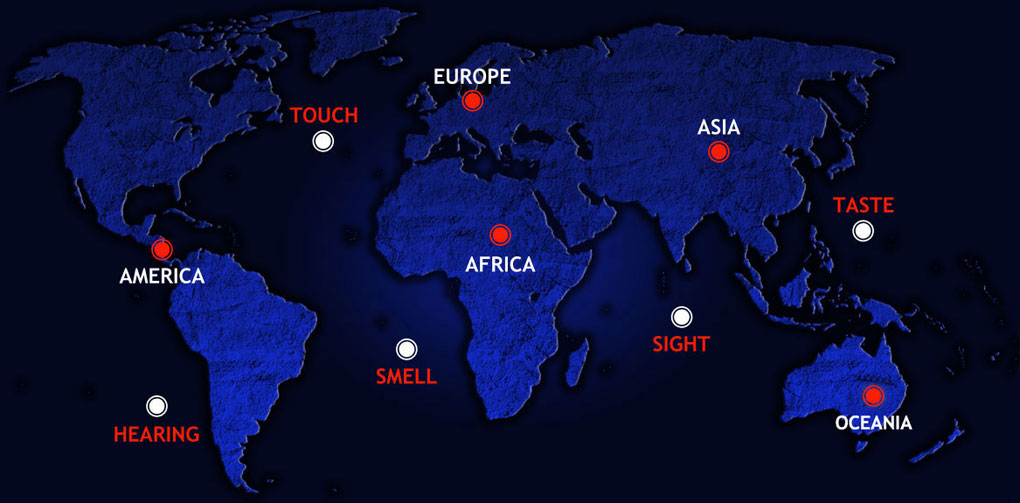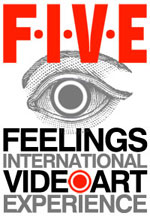

Sight is the ability to interpret the surrounding environment by processing information that is contained in visible light. The resulting perception is also known as eyesight, sight, or vision (adjectival form: visual, optical, or ocular). The various physiological components involved in vision are referred to collectively as the visual system, and are the focus of much research in psychology, cognitive science, neuroscience, and molecular biology.
The visual system in humans and animals allows individuals to assimilate information from their surroundings. The act of seeing starts when the lens of the eye focuses an image of its surroundings onto a light-sensitive membrane in the back of the eye, called the retina. The retina is actually part of the brain that is isolated to serve as a transducer for the conversion of patterns of light into neuronal signals. The lens of the eye focuses light on the photoreceptive cells of the retina, which detect the photons of light and respond by producing neural impulses. These signals are processed in a hierarchical fashion by different parts of the brain, from the retina upstream to central ganglia in the brain.
Note that up until now much of the above paragraph could apply to octopuses, molluscs, worms, insects and things more primitive; anything with a more concentrated nervous system and better eyes than say a jellyfish. However, the following applies to mammals generally and birds (in modified form): The retina in these more complex animals sends fibers (the optic nerve) to the lateral geniculate nucleus, to the primary and secondary visual cortex of the brain. Signals from the retina can also travel directly from the retina to the superior colliculus.
(source: Wikipedia)
Taste, gustatory perception, or gustation is one of the five traditional senses. Taste is the sensation produced when a substance in the mouth reacts chemically with receptors of taste buds. Taste, along with smell (olfaction) and trigeminal nerve stimulation (which also handles touch for texture, also pain, and temperature), determines flavors, the sensory impressions of food or other substances.
Humans perceive taste through sensory organs called taste buds, or gustatory calyculi, concentrated on the top of the tongue. The tongue is covered with thousands of small bumps called papillae, which are easily visible to the naked eye. Within each papilla are hundreds of taste buds, the organ of taste transduction. There are between 2000 and 5000 taste buds that are located on the back and front of the tongue. Others are located on the roof, sides and back of the mouth, and in the throat. Each taste bud contains 50 to 100 taste receptor cells. Taste perception fades with age: On average, people lose half their taste receptors by time they turn 20.
The sensation of taste can be categorized into five basic tastes: sweetness, sourness, saltiness, bitterness, and umami. Taste buds are able to differentiate among different tastes through detecting interaction with different molecules or ions. Sweet, umami, and bitter tastes are triggered by the binding of molecules to G protein-coupled receptors on the cell membranes of taste buds. Saltiness and sourness are perceived when alkali metal or hydrogen ions enter taste buds, respectively. As taste senses both harmful and beneficial things, all basic tastes are classified as either aversive or appetitive, depending upon the effect the things they sense have on our bodies. Sweetness helps to identify energy-rich foods, while bitterness serves as a warning sign of poisons.
The basic tastes contribute only partially to the sensation and flavor of food in the mouth — other factors include smell, detected by the olfactory epithelium of the nose; texture, detected through a variety of mechanoreceptors, muscle nerves, etc.; temperature, detected by thermoreceptors; and coolness (such as of menthol) and hotness (pungency), through chemesthesis.
(source: Wikipedia)
While touch (also called tactile perception or tactual perception) is considered one of the five traditional senses, the impression of touch is formed from several modalities. In medicine, the colloquial term touch is usually replaced with somatic senses to better reflect the variety of mechanisms involved.
Somatic senses are sometimes referred to as somesthetic senses, with the understanding that somesthesis includes touch, proprioception and (depending on usage) also haptic perception.
The system reacts to diverse stimuli using different receptors: thermoreceptors, nociceptors, mechanoreceptors and chemoreceptors. Transmission of information from the receptors passes via sensory nerves through tracts in the spinal cord and into the brain. Processing primarily occurs in the primary somatosensory area in the parietal lobe of the cerebral cortex.
The cortical homunculus was devised by Wilder Penfield.
At its simplest, the system works when activity in a sensory neuron is triggered by a specific stimulus such as heat; this signal eventually passes to an area in the brain uniquely attributed to that area on the body—this allows the processed stimulus to be felt at the correct location. The point-to-point mapping of the body surfaces in the brain is called a homunculus and is essential in the creation of a body image. This brain-surface (cortical) map is not immutable, however. Dramatic shifts can occur in response to stroke or injury.
(source: Wikipedia)
Olfaction or olfactory perception is the sense of smell. This sense is mediated by specialized sensory cells of the nasal cavity of vertebrates, which can be considered analogous to sensory cells of the antennae of invertebrates. In humans, olfaction occurs when odorant molecules bind to specific sites on the olfactory receptors. These receptors are used to detect the presence of smell. They come together at the glomerulus, a structure which transmits signals to the olfactory bulb (a brain structure directly above the nasal cavity and below the frontal lobe). Many vertebrates, including most mammals and reptiles, have two distinct olfactory systems—the main olfactory system, and the accessory olfactory system (used mainly to detect pheromones). For air-breathing animals, the main olfactory system detects volatile chemicals, and the accessory olfactory system detects fluid-phase chemicals. Olfaction, along with taste, is a form of chemoreception. The chemicals themselves that activate the olfactory system, in general at very low concentrations, are called odorants. Although taste and smell are separate sensory systems in land animals, water-dwelling organisms often have one chemical sense.
Volatile small molecule odorants, non-volatile proteins, and non-volatile hydrocarbons may all produce olfactory sensations. Some animal species are able to smell carbon dioxide in minute concentrations. Taste sensations are caused by small organic molecules and proteins.
(source: Wikipedia)
Hearing, auditory perception, or audition is the ability to perceive sound by detecting vibrations, changes in the pressure of the surrounding medium through time, through an organ such as the ear. Sound may be heard through solid, liquid, or gaseous matter. It is one of the traditional five senses. The inability to hear is called deafness.
In humans and other vertebrates, hearing is performed primarily by the auditory system: vibrations are detected by the ear and transduced into nerve impulses that are perceived by the brain (primarily in the temporal lobe). Like touch, audition requires sensitivity to the movement of molecules in the world outside the organism. Both hearing and touch are types of mechanosensation.
(source: Wikipedia)
The Europe's international tour schedule:
Partner: Fonlad Festival in Coimbra / Portugal / On 2014-04-26 (read about screening)
Partner: King's College London in London / United Kingdom / From 2014-05-07 to 2014-05-17(read about screening) Partner: New Bulgarian University in Sofia / Bulgaria / On 2014-05-16 (read about screening) Partner: Film Studio JEB'YE production in Ivano-Frankivsk / Ukraine / From 2014-05-24 to 2014-05-25(read about screening) Partner: Light Vessel 21 in Gillingham, Kent / United Kingdom / From 2014-05-26 to 2014-05-30(read about screening) Partner: Armenian Center for Contemporary Experimental Art in Erevan / Armenia / On 2014-06-06 (read about screening) Partner: Demolden Video Project in Santander / Spain / On 2014-06-22 (read about screening) Partner: Room in Kent / United Kingdom / From 2014-06-24 to 2014-06-30(read about screening) Partner: Open Arts Foundation in Plovdiv / Bulgaria / From 2014-09-12 to 2014-09-13(read about screening) Partner: International Festival of Computer Arts in Maribor / Slovenia / From 2014-09-25 to 2014-09-27(read about screening) Partner: Athens Video Art Festival in Athens / Greece / From 2014-10-02 to 2014-10-05(read about screening) Partner: OLE.01 International Festival of Electronic Literature in Naples / Italy / On 2014-10-14 (read about screening) Partner: Cinematica in Ancona / Italy / From 2014-10-15 to 2014-10-18(read about screening) Partner: Photon Gallery in Ljubljana / Slovenia / On 2014-10-28 (read about screening) Partner: Intramurs in Valencia / Spain / On 2014-11-13 (read about screening) Partner: ArtmusicEvent in Padua / Italy / From 2014-11-28 to 2014-11-30(read about screening) Partner: Pulimentos del Norte in Bilbao / Spain / On 2014-12-10 (read about screening)
The America's international tour schedule:
Partner: Richland College in Dallas / United States / From 2014-04-21 to 2014-04-25(read about screening) Partner: Richland College in Dallas / United States / From 2014-04-21 to 2014-04-22(read about screening) Partner: Elgalpon Espacio in Lima / Peru / On 2014-07-17 (read about screening) Partner: Seed Space in Nashville / United States / From 2014-08-02 to 2014-10-24(read about screening) Partner: Centre 3 for Print and Media Arts in Hamilton / Canada / On 2014-08-08 (read about screening) Partner: VibraFusionLab in London / Canada / On 2014-10-11 (read about screening) Partner: Centro Cultural de España in Montevideo / Uruguay / From 2014-10-15 to 2014-12-15(read about screening) Partner: Webster University Film Series in St. Louis / United States / From 2014-11-08 to 2014-11-09(read about screening) Partner: Torrance Art Museum in Torrance / United States / From 2014-11-08 to 2014-12-05(read about screening) Partner: VideoBabel International Festival in Cusco / Peru / On 2014-11-24 (read about screening)
The Asia's international tour schedule:
Partner: Muzaplus in Jaffa / Israel / From 0000-00-00 to 2014-12-13(read about screening) Partner: Beijing Institute of Fashion Technology (BIFT) in Beijing / China / On 2014-04-02 (read about screening) Partner: Now & After in Moscow / Russian Federation / On 2014-04-17 (read about screening) Partner: Inter Art Center / Gallery in Beijing / China / From 2014-05-17 to 2014-05-18(read about screening) Partner: Jaaga Gallery in Bangalore / India / From 2014-08-08 to 2014-08-09(read about screening) Partner: LXT Film Funds in Beijing / China / From 2014-08-23 to 2014-08-31(read about screening) Partner: Video Artist Iran in Isfahan / Iran / From 2014-10-10 to 2014-10-15(read about screening) Partner: American University in Dubai in Dubai / United Arab Emirates / On 2014-11-18 (read about screening)
The Africa's international tour schedule:
Partner: Alle School of Fine Arts and Design in Addis Abeba / Ethiopia / On 2014-05-01 (read about screening)
Partner: Netsa Art Village in Addis Abeba / Ethiopia / On 2014-05-03 (read about screening)
Partner: Mediterranean Biennale of Contemporary Art in Oran / Algerie / From 2014-06-08 to 2014-06-10(read about screening) Partner: Digital Marrakech Festival in Marrakech / Morocco / From 2014-11-26 to 2014-11-28(read about screening)
The Oceania's international tour schedule:
